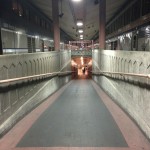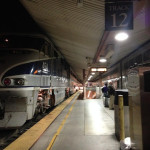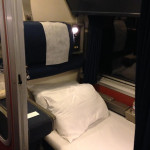“You always meet such nice people on the train,” said the man sitting next to me at lunch. The dining car followed the railroad tradition of community seating. The dining room attendant sat each person or party in order from the front of the car to the back, filling each table. So Mom and I sat with the man, who set out from Los Angeles to Houston to have Thanksgiving with family and friends, and a woman traveling from San Diego to Maryland for her mother’s funeral.
The man was right. Everyone on the train has been courteous, patient, warm. In the 36-hour trip, not once had there been an anxious moment. Not at my starting point, at Los Angeles’ Union Station, where dozens of us stood in line for our boarding passes but no one had to go through security or any level of disrobing. Not on the train platform, where we newbies asked cheerful attendants questions they had heard hundreds of times before. And not on the train itself, where we were jostled along turns and on uneven rails.
Is it that only nice people take trains? Or that traveling by train brings out the nice in all of us? Traveling by train … making your way in stops and starts … across the unfolding countryside … leaves you no option but to slow down and enjoy the ride. There is also some self-selection of patient passengers. Busy people pushing towards their next business meeting didn’t travel by train. There are no bi-coastal work-weeks via Amtrak. There is no wifi on this train to help passengers do business on their way to work. This is travel for those with either the time or enough social anxiety to take the slow road over the super-stress of holiday flights.
I chose Amtrak as an homage to both the 50th anniversary of Steinbeck’s Travels with Charley and the recent resurrection of train-travel across America and within our growing cities. As an ecological planner and designer, I want to better understand how cities embrace transit-oriented-development, whether long-standing systems or still evolving. So, I arranged a trip from Los Angeles to New York, with stops in Fort Worth, Saint Louis, Chicago and New York. My mom joined me in Tucson, in honor of her 75th birthday.
AMTRAK Day One: Los Angeles
Union Station, Los Angeles
My sister and son dropped me off at Union Station an hour before the train was to leave. The line for boarding passes wound around the entire rehabbed wooden seating section that is now only open to train passengers.
“Where are you headed?” the man behind me asked. Bent over, he was about my height, but I could tell he used to be quite a bit taller. He was likely in his 70s and wore a plaid shirt tucked neatly into green pants. The letters “PC” followed by three numbers adorned his blue, billed hat.
“Chicago and New York,” I answered. “To spend Thanksgiving with my family.”
“Oh, New York … that’s a crazy town,” he said. He raised his eyebrows and shook his head and pushed his lower lip forward with his chin. “Full of drinking and dancing.”
“My brother lives there,” I said.
“Oh yeah? What does he do?”
“He’s a bartender,” I said flatly, for effect.
“See?” he said, chuckling and shaking his head.
“I’m just kidding,” I said. “I mean, he is a bartender, but he is first a painter.”
“What kind of painting?” he asked.
“Portraits,” I said.
“You’d make a pretty portrait,” he said, nodding his head.
“Thank you,” I said. And then after a moment I asked him, “Where are you heading?”
“Back home to Texas,” he said. “I’m coming from Albany, Oregon … see that tall box?” He pointed across the seating area to a seat with a tall box sticking up under a coat with the letters USN.
“Yeah.”
“That’s a pelican I found down by the Port … it’s made of mahogany.” Again, the eyebrows and the lip.
“It must be beautiful,” I said, gathering the meaning behind his expression.
“I was in New York in 1963 for New Year’s Eve,” he said. “I took a train to White Plains to visit a friend of mine after our service … we chopped wood for two days, then took the train to Penn Station, then took a cab to Times Square, and …” he raised his eyebrows, dipped his head and pushed out his lower lip again, letting me surmise the rest. “They boarded up the windows because we were a wild bunch.”
The people in front of us shuffled forward, and as we moved along the man behind me perched on the arm of any empty chair. He never stopped talking. Halfway to the ticket booth, he perched beside a man wearing a full white beard and brown coveralls.
“Howdy Chief,” he said in greeting.
“How,” the man said back. He nodded at the pelican man’s hat. “I don’t look like a chief, but you look like a captain … what boat?”
“It was a World War II vessel,” he answered. “We restored it.”
“I was gonna say, you don’t look old enough for World War II,” the bearded man said.
“Nah, I served ’56-’59.”
“I did ’77-’80,” the bearded man responded. “My ship was the Midway, she’s now docked in San Diego, as part of the museum.”
“I’ve been on the Midway,” I said, happy to relate something to the conversation.
“So have I!” the bearded man enthused back. “Why were you on it?”
“I took my sons,” I said.
“Are they in the service?”
“No, but my 17-year-old wants to be,” I said. “At least he did then.”
“You don’t look like you could have a 17-year-old,” the pelican man said. “I would have said you were in your mid-20s.” Now I knew he was just flattering me.
“Thank you,” I said. “You’re sweet.”
It took 45 minutes to reach the window, where the woman informed me I didn’t need a boarding pass since I was already assigned a roomette.
“I’m so sorry,” she said. “Someone should have told you you didn’t have to wait in that long line!”
I didn’t mind.



